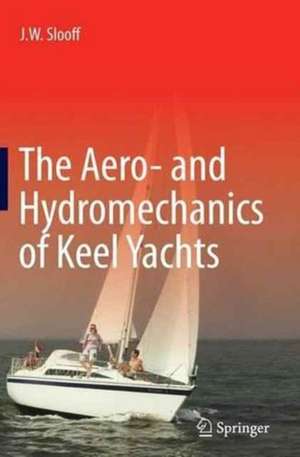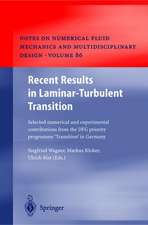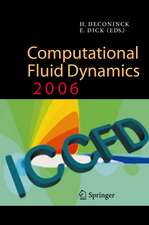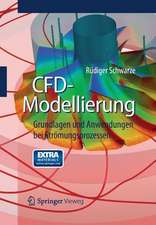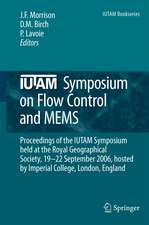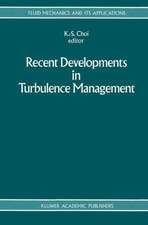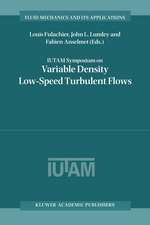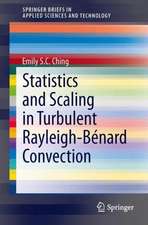The Aero- and Hydromechanics of Keel Yachts
Autor J.W. Slooffen Limba Engleză Paperback – 13 oct 2016
Readers are provided with the basic principles of physics and general mechanics that will assist their understanding of the fluid mechanics of sailing yachts. Rich appendices cover not only in-depth,mathematical-physical treatments and derivations for those wishing to explore further, but also helpful summaries of basic mathematical notions for those wishing to refresh their knowledge.
This work explores keel yachts, specifically single-masted mono-hulls with ‘fore-and-aft’, Bermuda-rigged sails. However, much of it is applicable to other types of sailing vessels such as multi-hulls, yachts with multiple masts, windsurf boards and the like.
Yachtsmen, yacht designers and professionals of sailing technology will all find something of interest in this work which provides explanations of the mechanics of sailing in a way that is scientifically justified, whilst remaining appealing to those wishing to use their knowledge on-board a sailing vessel.
For some years I’m teaching a course on “Sailing Yacht Design” in the master class of yacht design. Actually, I’ve found your book the best one about physics of a sailing yacht I’ve ever read.
Edward Canepa, assistant professor in Fluid Machinery at the University of Genova (Italy)
…very impressed, no wonder it took so long. It is “everything I ever wanted to know about sailing but was afraid to ask” !
Frank Woodward, former computational fluid dynamicist at the Boeing Company and Analytical Methods Inc., and a cruising yachtsman
| Toate formatele și edițiile | Preț | Express |
|---|---|---|
| Paperback (1) | 480.04 lei 38-44 zile | |
| Springer International Publishing – 13 oct 2016 | 480.04 lei 38-44 zile | |
| Hardback (1) | 616.13 lei 38-44 zile | |
| Springer International Publishing – 6 mai 2015 | 616.13 lei 38-44 zile |
Preț: 480.04 lei
Preț vechi: 592.64 lei
-19% Nou
Puncte Express: 720
Preț estimativ în valută:
91.86€ • 96.15$ • 76.45£
91.86€ • 96.15$ • 76.45£
Carte tipărită la comandă
Livrare economică 27 martie-02 aprilie
Preluare comenzi: 021 569.72.76
Specificații
ISBN-13: 9783319365572
ISBN-10: 3319365576
Pagini: 654
Ilustrații: XXIX, 625 p. 200 illus. in color.
Dimensiuni: 155 x 235 x 35 mm
Ediția:Softcover reprint of the original 1st ed. 2015
Editura: Springer International Publishing
Colecția Springer
Locul publicării:Cham, Switzerland
ISBN-10: 3319365576
Pagini: 654
Ilustrații: XXIX, 625 p. 200 illus. in color.
Dimensiuni: 155 x 235 x 35 mm
Ediția:Softcover reprint of the original 1st ed. 2015
Editura: Springer International Publishing
Colecția Springer
Locul publicării:Cham, Switzerland
Cuprins
1 Introduction.- 2 Sailing Yacht Geometry and Mass Properties.-
3 Forces, Moments and Motions.- 4 Sailing: Basic Mechanics.-
5 Elements of Fluid Mechanics (Air and Water).- 6 Forces Under Water: Hydromechanics.- 7 Forces Above the Water Surface: Aerodynamics.- 8 Encore: Sailing; Aerodynamics Plus Hydromechanics.- Retrospection.- Appendices.
3 Forces, Moments and Motions.- 4 Sailing: Basic Mechanics.-
5 Elements of Fluid Mechanics (Air and Water).- 6 Forces Under Water: Hydromechanics.- 7 Forces Above the Water Surface: Aerodynamics.- 8 Encore: Sailing; Aerodynamics Plus Hydromechanics.- Retrospection.- Appendices.
Notă biografică
Johannes (‘Joop’*)) W. Slooff*) is a (retired) fluid dynamicist by profession. He is also a cruising yachtsman (not yet retired).
In 1964 he obtained his degree in aeronautical engineering at Delft University of Technology in the Netherlands, also having followed the Diploma Course at the Von Karman Institute for Fluid Dynamics (VKI) in Rhode-St.Genèse, near Brussels in Belgium.
In 1965 he joined the National Aerospace Laboratory (NLR) in Amsterdam, The Netherlands, as a research scientist in aerodynamics, with airfoil and wing design and applied computational aerodynamic design methodologies as his main topics of research. Much of this research was done in support of and in close collaboration with the former Fokker Aircraft Company.
In 1976 he was appointed as head of the Theoretical Aerodynamics Department of NLR and in 1986 as chief of the Fluid Dynamics Division, a position he held until his retirement in 2001. From 1987 to 2001 he was also a part-time professorin applied computational aerodynamics at the Aerospace Faculty of Delft University of Technology.
He has served on several national and international advisory committees such as the Fluid Dynamics Panel of the former Advisory Group for Aeronautical Research and Development (AGARD) of NATO, the Research and Technology Organisation (RTO) of NATO, the Applied Aerodynamics Committee of the American Institute for Aeronautics and Astronautics (AIAA), the Group for Aeronautical Research and Technology in Europe (GARTEUR), the Technical Advisory Committee of the Von Kármán Institute for Fluid Dynamics in Belgium and the Scientific Advisory Council of the Maritime Research Institute of the Netherlands (MARIN). In 1996 he delivered the 36th Lanchester Lecture for the Royal Aeronautical Society in London. He is the 1997 recipient of the Von Kármán Medal of AGARD/NATO, in recognition of his outstanding contributions to that organisation. He is also a Fellow of the American Institute for Aeronautics and Astronautics.
In 1964 he obtained his degree in aeronautical engineering at Delft University of Technology in the Netherlands, also having followed the Diploma Course at the Von Karman Institute for Fluid Dynamics (VKI) in Rhode-St.Genèse, near Brussels in Belgium.
In 1965 he joined the National Aerospace Laboratory (NLR) in Amsterdam, The Netherlands, as a research scientist in aerodynamics, with airfoil and wing design and applied computational aerodynamic design methodologies as his main topics of research. Much of this research was done in support of and in close collaboration with the former Fokker Aircraft Company.
In 1976 he was appointed as head of the Theoretical Aerodynamics Department of NLR and in 1986 as chief of the Fluid Dynamics Division, a position he held until his retirement in 2001. From 1987 to 2001 he was also a part-time professorin applied computational aerodynamics at the Aerospace Faculty of Delft University of Technology.
He has served on several national and international advisory committees such as the Fluid Dynamics Panel of the former Advisory Group for Aeronautical Research and Development (AGARD) of NATO, the Research and Technology Organisation (RTO) of NATO, the Applied Aerodynamics Committee of the American Institute for Aeronautics and Astronautics (AIAA), the Group for Aeronautical Research and Technology in Europe (GARTEUR), the Technical Advisory Committee of the Von Kármán Institute for Fluid Dynamics in Belgium and the Scientific Advisory Council of the Maritime Research Institute of the Netherlands (MARIN). In 1996 he delivered the 36th Lanchester Lecture for the Royal Aeronautical Society in London. He is the 1997 recipient of the Von Kármán Medal of AGARD/NATO, in recognition of his outstanding contributions to that organisation. He is also a Fellow of the American Institute for Aeronautics and Astronautics.
Textul de pe ultima copertă
How and why does sail boat performance depend on the configuration and trim of boat and sails? This book provides the yachtsman with answers in a relatively straightforward account of the physical mechanisms of sailing. It presents an accessible overview of the fluid dynamic aspects of sailing and sailing technology, addressing both aeromechanics and hydromechanics.
Readers are provided with the basic principles of physics and general mechanics that will assist their understanding of the fluid mechanics of sailing yachts. Rich appendices cover not only in-depth, mathematical-physical treatments and derivations for those wishing to explore further, but also helpful summaries of basic mathematical notions for those wishing to refresh their knowledge.
This work explores keel yachts, specifically single-masted mono-hulls with ‘fore-and-aft’, Bermuda-rigged sails. However, much of it is applicable to other types of sailing vessels such as multi-hulls, yachts with multiple masts, windsurf boards and the like.
Yachtsmen, yacht designers and professionals of sailing technology will all find something of interest in this work which provides explanations of the mechanics of sailing in a way that is scientifically justified, whilst remaining appealing to those wishing to use their knowledge on-board a sailing vessel.
Readers are provided with the basic principles of physics and general mechanics that will assist their understanding of the fluid mechanics of sailing yachts. Rich appendices cover not only in-depth, mathematical-physical treatments and derivations for those wishing to explore further, but also helpful summaries of basic mathematical notions for those wishing to refresh their knowledge.
This work explores keel yachts, specifically single-masted mono-hulls with ‘fore-and-aft’, Bermuda-rigged sails. However, much of it is applicable to other types of sailing vessels such as multi-hulls, yachts with multiple masts, windsurf boards and the like.
Yachtsmen, yacht designers and professionals of sailing technology will all find something of interest in this work which provides explanations of the mechanics of sailing in a way that is scientifically justified, whilst remaining appealing to those wishing to use their knowledge on-board a sailing vessel.
Caracteristici
This is THE book on the aero- and hydrodynamics of sailing Contains unique, scientifically justified descriptions of the dependence of the performance of sailing yachts on their configuration and the underlying physical mechanisms Bridges the gap between the few existing books on the aero- and hydrodynamics of sailing and the more popular books that deal with the 'what' and 'how' but not with the 'why' of sailing yacht configurations and boat trim Includes supplementary material: sn.pub/extras
